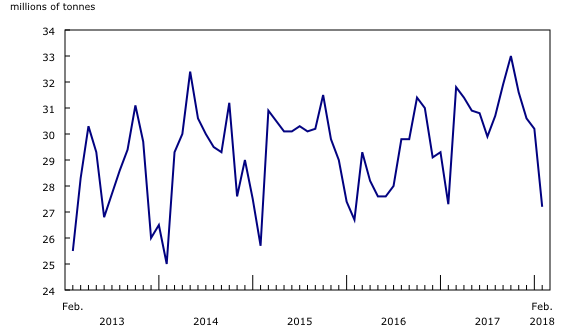The volume of rail freight carried in Canada totalled 27.2 million tonnes in February, down 0.2% from February 2017, according to the latest release from Statistics Canada April 25.
Freight originating in Canada decreased 1.8% from the same month last year to 24.2 million tonnes. Non-intermodal freight fell by 2.1% to 264,000 carloads in February. The amount of freight loaded into these cars fell 2.3% from February 2017 to 21.4 million tonnes.
In February, the commodities with the largest increase in tonnage compared with February 2017 were iron ores and concentrates (+522 000 tonnes or +12.9%), potash (+198 000 tonnes or +13.2%), gypsum (+88 000 tonnes or +215.7%), other metallic ores and concentrates (+84 000 tonnes or +35.1%) and alumina (+79 000 tonnes or +29.9%).
Conversely, tonnages declined over the same period for colza seeds (canola) (-289 000 tonnes or -33.3%), wheat (-260,000 tonnes or -17.6%) and fresh, chilled or dried vegetables (-170 000 tonnes or -42.7%).
Intermodal freight loadings rose 5.0% from February 2017 to 187,000 units in February 2018. The gain stemmed from a 5.0% increase in containers-on-flat-cars, and an 8.3% increase for trailers-on-flat-cars. In terms of weight, intermodal traffic increased 2.3% to 2.7 million tonnes.
Freight traffic received from the United States rose 14.3% to 3.0 million tonnes as a result of increases in both non-intermodal (+15.0%) and intermodal (+5.6%) freight.

